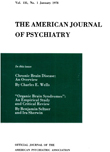CLINICAL AND ELECTRO-PHYSIOLOGICAL OBSERVATIONS FOLLOWING ELECTROSHOCK
Abstract
Electroencephalographic observations have been made on 129 patients approximately half of whom received convulsant therapy by means of alternating current and the other half by means of unidirectional fluctuating current.
1. It was found that there was a significant increase in the occurrence of cortical slow wave formation in the group receiving alternating current compared with the group receiving unidirectional fluctuating current.
2. The group receiving unidirectional fluctuating current showed a differential slow wave response. The full remissions did not exhibit severe cerebral dysrhythmia. The social remissions showed much less cortical slow wave activity than the group requiring continued mental hospital care. Therefore, the appearance of cortical dysrhythmia following electroshock by unidirectional fluctuating current has prognostic value.
In addition to the patients treated in the research unit of the Toronto Psychiatric Hospital under the Supervision of Dr. C. B. Farrar, the above series includes patients from the Neuro-psychiatric Clinic of the Toronto Western Hospital by permission of Dr. H. K. Detweiler, physician-in-chief, and patients from the Ontario Hospital, New Toronto under the care of Dr. N. L. Easton and the supervision of Dr. T. D. Cumberland. We wish to express our appreciation to Mr. M. Wyand, radio technician of the research unit, for his valuable assistance in obtaining the electroencephalographic data presented.
Access content
To read the fulltext, please use one of the options below to sign in or purchase access.- Personal login
- Institutional Login
- Sign in via OpenAthens
- Register for access
-
Please login/register if you wish to pair your device and check access availability.
Not a subscriber?
PsychiatryOnline subscription options offer access to the DSM-5 library, books, journals, CME, and patient resources. This all-in-one virtual library provides psychiatrists and mental health professionals with key resources for diagnosis, treatment, research, and professional development.
Need more help? PsychiatryOnline Customer Service may be reached by emailing [email protected] or by calling 800-368-5777 (in the U.S.) or 703-907-7322 (outside the U.S.).



